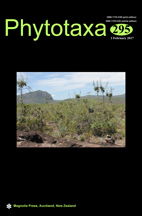Abstract
A new species, Hedysarum cuonanum (Fabaceae, Hedysareae), is described from the eastern Himalaya in China. This new species is similar to H. xizangense, but differs by its lanceolate or narrowly elliptic leaflet blade, ovate or lanceolate bracteole about half the length of calyx tube, acute or obtuse standard apex, and mucronate keel apex. It also resembles H. longigynophorum, but can be distinguished by its leaflet blade with 13–19 secondary veins on each side, abaxial calyx tooth about 1.5 times as long as the adaxial teeth, standard as long as keel, and elliptic or ovate loment article. Phylogenetic analyses based on the nuclear ITS, ETS sequences, and the plastid psbA-trnH, trnC-petN, petN-psbM sequences showed that H. cuonanum is sister to H. xizangense, and the H. cuonanum + H. xizangense clade is then sister to H. longigynophorum.

